
~~~~~~~~~~~~~~~~~~~~~~~~~~~~~~~~~~~~~~~~~~~
Live Earth Farm (Com)Post
8th Harvest Week, Winter 2007/2008
***Last Winter Share***
Wednesday March 5th, 2008
~~~~~~~~~~~~~~~~~~~~~~~~~~~~~~~~~~~~~~~~~~~
In this issue
--Greetings from Farmer Tom
--What's that rotten Apple doing in my share?
--When will the regular CSA season
start?
--Pictures around the farm
--What's in the box this week
--Notes from Debbie's Kitchen
--Calendar of Events
--Contact Information
" It was then the month of March, the days were growing
longer, winter was departing. Winter always carries with it something
of our sadness; then April came, that daybreak of summer, fresh like
every dawn, gay like every childhood; weeping a little sometimes like
the infant that it is. Nature in this month has charming gleams which
pass from the sky, the clouds, the trees, the fields, and the flowers,
into the heart of man. "
~
Victor Hugo, from Les Miserables
Greetings from Farmer Tom
~~~~~~~~~~~~~~~~~~~~~~~~~~~~~~~~~~~~~~~~~~~~~~~~
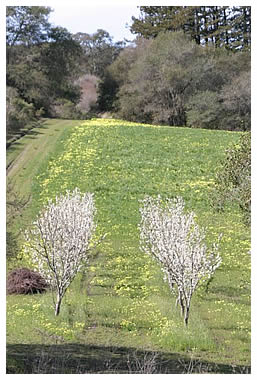 Technically
speaking, the start of spring is not until the 21st of March, but the weather
outside has triggered a serious outbreak of spring fever. Fields
are covered in yellow blooming mustards and sourgrass, the cover crop
is lush and green, the Japanese plums and apricots are in full bloom,
the shade house is jam packed with seedlings ready to be planted, and
Strawberries are starting to ripen. As the soil warms, the earth
awakens to receive the farmer's seeds into her fertile embrace.
Technically
speaking, the start of spring is not until the 21st of March, but the weather
outside has triggered a serious outbreak of spring fever. Fields
are covered in yellow blooming mustards and sourgrass, the cover crop
is lush and green, the Japanese plums and apricots are in full bloom,
the shade house is jam packed with seedlings ready to be planted, and
Strawberries are starting to ripen. As the soil warms, the earth
awakens to receive the farmer's seeds into her fertile embrace.Planting for me is a reminder how much we are truly children of this miraculous Earth. Every seed we plant is an act of faith, faith in life to grow and multiply into abundant nourishing gifts. Within Nature's cyclical rhythm however, most of these bountiful gifts won't be mature until later in the season; although the air is buzzing with life, Spring is actually one of the scarcest times of the year. I am always nervous, given the uncertainty of Spring, as to whether or not conditions will allow me to have enough harvestable crops to start the season. Our energy is focused on preparing the fields, planting and nurturing the first crops, and making sure our orchards and over-wintering cane berries get the best possible conditions for a healthy start.
As we harvest and pack the last winter share, although I am grateful for the abundance we enjoyed, I am otherwise ready to embrace the seasonal transition – and looking forward to again bite into a sweet, juicy strawberry! We want to thank you all for your commitment and support during our second Live Earth Farm Winter CSA. I am sure you have enough cabbage saved up to hold you over until our first share in April. We wish you a Happy start of Spring, and please give us your feedback so we can continue integrating your ideas. Hope to see you all here on the farm to celebrate together on the land that nourishes us.
– Tom
<back to top>
What's that rotten Apple doing in my share?
~~~~~~~~~~~~~~~~~~~~~~~~~~~~~~~~~~~~~~~~~~~~~~~~
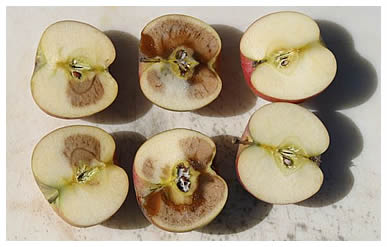 In short, it's called Apple Bitter Pit. Over the last few weeks many of you have
probably received a few apples with a rotten core; I apologize – I only
started noticing when you did. This condition – which is virtually undetectable
from the outside of the fruit (as you probably have already noticed!) – is not caused
by some kind of insect or fungal pest, but rather is a common physiological symptom
in apples known as "Bitter Pit," and is caused by a deficiency in Calcium.
Low levels of calcium in the fruit are due to competition with shoots for calcium,
which may be aggravated by weather conditions. Hot, dry weather in July or August
tends to increase the incidence of Bitter Pit. Irregular irrigation may also
increase bitter pit. The Fuji apples you have been getting were picked off a
young orchard, which also may have experienced some watering irregularities. Maybe
it was just a particular batch; it's hard to tell. The Pippins in this week's
share are from a different source. They may not look pretty from the outside,
but they have a great flavor and are harvested of off very old trees... and I
haven't noticed them having any Bitter Pit. This will be the last of the apples – we
won’t be packing more until apple season starts again in August.
In short, it's called Apple Bitter Pit. Over the last few weeks many of you have
probably received a few apples with a rotten core; I apologize – I only
started noticing when you did. This condition – which is virtually undetectable
from the outside of the fruit (as you probably have already noticed!) – is not caused
by some kind of insect or fungal pest, but rather is a common physiological symptom
in apples known as "Bitter Pit," and is caused by a deficiency in Calcium.
Low levels of calcium in the fruit are due to competition with shoots for calcium,
which may be aggravated by weather conditions. Hot, dry weather in July or August
tends to increase the incidence of Bitter Pit. Irregular irrigation may also
increase bitter pit. The Fuji apples you have been getting were picked off a
young orchard, which also may have experienced some watering irregularities. Maybe
it was just a particular batch; it's hard to tell. The Pippins in this week's
share are from a different source. They may not look pretty from the outside,
but they have a great flavor and are harvested of off very old trees... and I
haven't noticed them having any Bitter Pit. This will be the last of the apples – we
won’t be packing more until apple season starts again in August.
<back to top>
When will the regular CSA season start?
~~~~~~~~~~~~~~~~~~~~~~~~~~~~~~~~~~~~~~~~~~~~~~~~
Debbie here. So that you all know what to expect, here’s the current
status of the CSA: This week, Weds. March 5th, is indeed the last share
of the Winter season. After that there will be a 4-week break, and then
the Regular CSA season will start the SECOND week
of April, Weds April
9th and Thursday April 10th (The day of week depends on where you pick
up).
I am busily getting all signups recorded and confirmed; most of you have probably gotten your confirmation if you sent in your payment; I have a few left to enter yet, and if you haven’t sent in your balance due, please do so soon, so I can get my database ready for season start! :-)
Tip: since I know we all struggle with spam in our email inboxes, I always try to make emails from the farm consistent. The subject line in any email I originate will always have the words "Live Earth Farm" followed by the related topic, so that you know what to scan for if you have lots of email to look through!
<back to top>
Pictures around the farm
~~~~~~~~~~~~~~~~~~~~~~~~~~~~~~~~~~~~~~~~~~~~~~~~
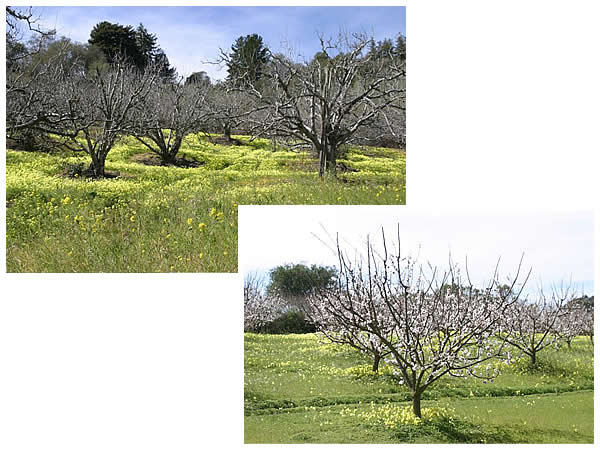
Above left, some very old apple trees (if you look closely, you can see
long 2x4s stacked against the trunks; these are deployed when the branches
are heavy with fruit, to help prevent them from breaking under the weight!).
Above right, some of the apricot trees in blossom on Live Earth Farm's
new property.
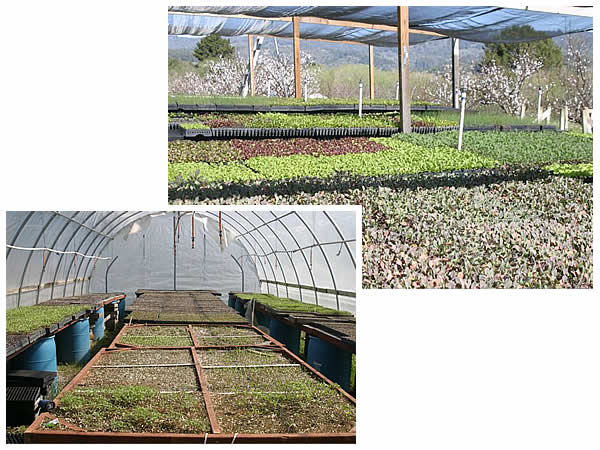
Above, the greenhouse and the 'shade house' – where seedlings are moved to
start acclimatizing them to the ambient outdoor temperatures (as opposed
to the warm greenhouse) before being planted out into the fields.
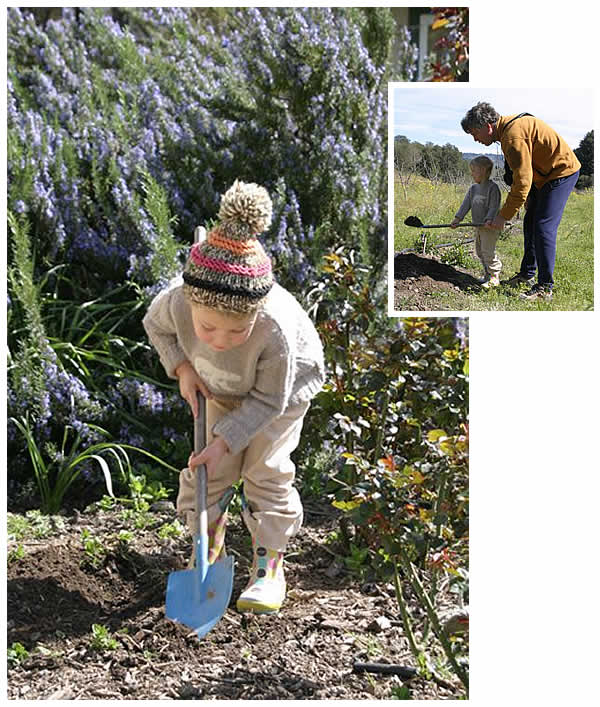 Little
'Farmer Elisa' and her daddy!
Little
'Farmer Elisa' and her daddy!
What's in the box this week
~~~~~~~~~~~~~~~~~~~~~~~~~~~~~~~~~~~~~~~~~~~~~~~~
Remember, sometimes there are last-minute substitutions
not reflected in this list!
Pippin apples – Billy Bob’s Orchard
White beets
Broccolini
Brussels sprouts
Red cabbage
Green cabbage
Carrots
Chard
Red Russian kale
Onions – Pinnacle Farm
Rutabagas
Winter squash - Lakeside
Bread (this week for the Santa Cruz County pickup locations: LEF, Soquel,
Aptos/Wavecrest, Seabright, West SC/Baldwin, Scotts Valley/Skypark)
<back to top>
Notes from Debbie's Kitchen
~~~~~~~~~~~~~~~~~~~~~~~~~~~~~~~~~~~~~~~~~~~~~~~~
Click
here to go to recipe database
This week I dug into my archive of recipes that members have emailed me over the years to find ones that suited our current box. What often happens is that people will learn a new way to use something in their box (and be all excited about it of course!), but by the time they send me their recipe, the season for that item has moved on! Thats why I always save them, because the seasons come round again!
Take care everyone I hope you all survive the 4-week hiatus from getting a box of farm veggies! Well be talking again in April, and by that time... strawberries!!! Spring is coming, I can feel it! - Debbie
Garlicky Sesame-Cured Broccoli Salad
from the Feb 20 New York Times Dining and Wine
section, sent to me by member Lisa Bautista Serves 6 to 8 as a side-dish (or
more as an hors d’oeuvre)
1 1/2 tsp. red wine vinegar
1 tsp. kosher salt, more to taste
~ 2 lbs. broccoli [or broccolini] cut into bite-size florets
3/4 C extra virgin olive oil
4 fat garlic cloves, minced
2 tsp. cumin seeds
2 tsp. roasted (Asian) sesame oil
Large pinch crushed red pepper flakes
1. In a large bowl, stir together the vinegar and salt. Add broccoli and toss
to combine.
2. In a large skillet, heat olive oil until hot, but not smoking. Add garlic
and cumin and cook until fragrant, about 1 minute. Stir in sesame oil and pepper
flakes. Pour mixture over broccoli and toss well. Let sit for at least 1 hour
at room temperature, and up to 48 (chill it if you want to keep it for more than
2 hours). Adjust seasonings (it may need more salt) and serve.
Butternut Broccoli Holiday Delight
by member Cynthia Neuendorffer
1 small butternut squash
1 head broccoli [or equivalent quantity of broccolini]
Half a small onion, diced
4 ounces Stilton cheese
Thyme
Port(or red wine and some sugar)
Raisins
Canned or fresh cranberry relish
Cynthia says, “I'm a minimalist, so I just steamed the veggies, but this
recipe could be done by sautéing or roasting too.”
Cook diced butternut squash with thyme, onion, and diced broccoli stalk.* When
almost done, add broccoli florets for the last few minutes of cooking time. [*If
using broccolini, I would say wait to add it all until the last part of the cooking;
the stalks are petite and won’t need that extra cooking time.]
Remove veggies from heat, crumble in stilton and allow to melt. Meanwhile in
a second pan (dishes dishes!), warm port and raisins. Once to boiling point,
add about 8 oz. cranberry relish and stir to mix.
Serve veggies with cranberry sauce to spoon over. Delightful!
Dori Sage – a Live Earth Farm recipe database fan from Woodland Hills,
CA – sent me the following recipe this winter. She says it is one
of her favorite recipes from Epicurious.com – “The squash is sweet,
the vinaigrette is sour and hot. Yumm!” – but that she’s made
some adjustments to the instructions for ease of preparation, as well as added
some alternate ingredient options (not everyone has fresh chilies or limes on
hand). The original recipe calls for Acorn squash, but this should be good with
any winter squash.
Roasted Winter Squash with Chile Vinaigrette
2 (1-1/2 to 1-3/4 lb.) acorn squash [or equivalent in other winter squash]
1/2 tsp. black pepper
1 tsp. salt
6 tbsp. olive oil
1 garlic clove
1 ½ tbsp. fresh lime juice, or to taste (OR red wine vinegar, OR orange
juice mixed with vinegar to sour it up) [I’d add “or lemon juice” – as
lots of us have lemon trees up here!]
1 to 2 tsps. finely chopped fresh hot red chile, including seeds (OR 1 to 2 tsps.
Sambal Oelek – a kind of Ground Fresh Chile Paste, OR Sriachi chile paste
(I'm not sure of spelling) to your taste
2 tbsp. chopped fresh cilantro (If you don't have any, just omit)
Preheat oven to 450F. Halve squash, peel, scoop out seeds (discard) and cut into
wedges [or finger-sized slices]. Combine 2 tbsp. of the oil, 3/4 tsp. salt, and
black pepper and toss squash pieces with mixture until coated. [Dori suggests
doing this in a plastic bag so you can shake until pieces are coated. I like
to do this in a glass bowl and toss with my hands.]
Arrange prepared squash on baking dishes - one layer deep only. (If you need
to use two roasting pans, switch positions in oven halfway through roasting so
that they cook evenly.) Roast until squash is tender, probably 15 to 20 minutes,
depending upon size of pieces.
While squash roasts, prepare vinaigrette. Mince garlic and mash to a paste
with remaining salt. Place in small bowl, whisk in juice, remaining oil, cilanto
and chile. Transfer roasted squash to serving platter and drizzle with vinaigrette.
The following recipe is from member Mary Lyn Azar; a posting on the LEFCSAfriend
yahoo group:
Beef and Root Vegetable Roast
Since we got a number of root vegetables last week [this post was from April
2008], I thought I'd share a recipe I've been using a lot this winter. This
comes from my sister-in-law's method of cooking potatoes, carrots, onions, and
stew beef but I've expanded it to include whatever made sense from that week's
box. This week, I took the rutabagas, beets (both peeled and cut into chunks),
half the carrots (washed well and cut into 1/2 inch segments), and two of the
green garlics (cut in half lengthwise and sliced up to where the leaves split
off). [We don’t have green garlic yet, but we ARE getting onions, so I’d
recommend cutting one or two into wedges and adding to the mix!] All of
that goes into an oven safe pot with a couple of tablespoons of vegetable oil,
salt, and pepper and is tossed. Then I put about a pound and a half of
stew beef on the top, drizzle on a bit more oil and a little more salt and pepper
and put it in the oven at 350 (beef still on top). When the beef browns,
I flip it, when it's browned on the other side I give the whole pot a good stir
and then stir it every 15-20 minutes until it is done (vegetables are easy to
pierce with a fork, roughly 1 1/2 hours total cooking time). Over the winter
I've also used winter squash, potatoes, and parsnips. When I don't have
green garlic I do half an onion and several cloves of garlic. The recipe
is really flexible and I use it with whatever I have available.
Here’s a recipe I’ve had in my “recipe ideas” inbox since
(gulp!) June of 2005! ;-) Longtime member Sumit Sen sent me this, saying “the
flavor is amazing, but it does require a trip to the Indian store [for special
ingredients].” He also says that it is ‘a much improved version of
a recipe I submitted a few years ago’ – I looked it up, and sure
enough, the old recipe is in the database back in 1999, called ‘South Indian
style Cabbage.”
South Indian spicy cabbage and dal
adapted from a South Indian cookbook called “Dashkin”
1 small cabbage chopped small (like for coleslaw)
1 chopped green chili (optional)
1/3 C peas
Spice mix:
1 tsp. urad dal (aka split black gram)
1 tsp. chana dal (aka split bengal gram)
1 tsp. mustard seeds
1 tsp. cumin seeds
1/2 tsp. asafoetida powder (aka hing)
1 dried red chili broken in 2 pieces
5-10 curry leaves
2 tbsp grated coconut (available frozen at Indian stores)
In a medium saucepan heat 1 tbsp. oil and add spice mix when hot. Fry on
moderate heat until mustard seeds start to pop and the dals turn golden brown,
taking care not to burn the spices. Split green chile and add to saucepan
along with curry leaves and stir for a few seconds until leaves darken. Add
cabbage, peas, green chili, salt to taste and cook on med-low heat until cabbage
is cooked. Add coconut and cook for a few minutes. Serve.
Here’s another recipe in my archives from 2005,
submitted by Kristin Schwarz:
Thai Slaw
from The Native Foods Restaurant cookbook by Tanya Petrovna
6 C shredded green cabbage
2 C shredded red cabbage
1 C shredded carrot
1 C roasted, unsalted, peanuts
1/2 C chopped green onion
1/4 tsp. sea salt
1/4 tsp. crushed red chilies (optional)
3/4 C Sesame Orange Vinaigrette (see recipe below)
Mix all ingredients together in a large bowl. Voila!
Other options:
- Add 1 cup chopped pineapple or mango to make it muy tropical.
- Garnish with roasted sesame seeds.
Sesame Orange Vinaigrette
makes 2 cups
1/2 C orange juice
1/4 C rice vinegar
1/4 C maple syrup
2 tbsp. grated ginger
3/4 C safflower or sunflower oil
1/4 C toasted sesame oil
1 tbsp. sea salt
1/4 tsp. white pepper
Puree OJ, rice vinegar, maple syrup, and ginger in a blender. With blender on
low speed, gradually add oils, salt, and white pepper.
. . . okay, and just one more for cabbage, since
that’s
what (if you’re
like me) you have the most of left! This one’s also from 2005, and was
given me by member Suzanne Purnell:
Really Purple Coleslaw
1 small head purple cabbage, shredded (about 6 cups)
1 small red onion, slivered (about ¼ cup)
¼ C dried red cherries, chopped
¼ C raspberry vinaigrette (or see alternative, below)
1 tbsp. raspberry preserves
salt and pepper
Shred cabbage using food processor. Sliver onion and chop dried cherries. Use
bottled raspberry dressing, or mix 1 part olive oil to 3 parts vinegar (I like
Cuisine Perel Black Fig vinegar [ooh, me too!!]); mix in raspberry preserves,
and add salt and pepper to taste. Stir together all ingredients and chill,
if possible.
[I bet this would be pretty with some minced fresh parsley added at the end,
or even some toasted nuts of some sort! Peanuts? Hazelnuts? Hmmm...]
And lastly, one by me!
Quick “pickled” white beets
I made this one up a few weeks ago, looking for something different to do with
my white beets. They’re not true ‘pickled’ (i.e. fermented),
but I use unfiltered, unpasteurized cider vinegar, which itself is the result
of fermentation. That’s why I cook the beets instead of heating the vinegar,
so as not to destroy the beneficial goodness of the unpasteurized vinegar!
1 quart jar
All those small white beets that are still in your refrigerator
Several fresh parsley sprigs, tops only
about a tsp. of fennel seed
one or two small bay leaves
¼ C cider vinegar mixed with ¾ C water
1 tsp. sugar or honey
1 tsp. sea salt
Peel beets and slice very thin (I used my 1mm slicing blade in my food processor,
but a mandoline would work too). Steam them a bare 5 minutes; since they’re
so thin they’ll cook quickly and you don’t want mush!
Meanwhile, stir sugar and salt into vinegar/water and stir to dissolve.
When the beets are done cooking but still nice and hot (the better to absorb
the pickling solution), put them into the jar, adding sprigs of parsley, the
bay leaves, and small scatterings of fennel seed as you go, so that it looks
pretty from the outside. Pour diluted vinegar mixture over all and shake gently
once or twice to distribute. You want all the beet slices to be submerged, so
poke them down with your finger if you need to. Put lid on jar and refrigerate.
These should keep (refrigerated) for several weeks. Eat as a snack, or little
side dish, or even as a small salad: place a small pile of beets on a nice lettuce
leaf.
<back to top>
2008 Calendar of Events
~~~~~~~~~~~~~~~~~~~~~~~~~~~
Click
here for calendar details on our website.
Winter "Five Thursdays" Mataganza Garden Internship - Feb 14, 21, 28, Mar
6, 13
Santa Cruz Permaculture Design course - one weekend/month for
6 months, Feb-July
Herbalism Classes at Live Earth Farm:
<>Herbal First Aid - March 15-16
<>Medicine Making - May 10-11
<> Cooking with Herbs - July 19-20
Summer Solstice Celebration - Saturday June 21st
Children's Mini-Camp - July 11th - 13th (Friday evening thorugh Sunday
noon)
Fall Equinox Cob Building Workshop and Campout - Sept. 20 and 21
Fine Farm Feast - Oct 4th
Fall Harvest Celebration - later in October (date TBA)
Contact Information
~~~~~~~~~~~~~~~~~~~~~~~~~~~
email Debbie at the farm (for any farm or CSA share-related business): farmers@cruzio.com
email Debbie at home (with newsletter input or recipes): deb@writerguy.com
farm phone: 831.763.2448
website: http://www.liveearthfarm.net
~~~~~~~~~~~~~~~~~~~~~~~~~~~